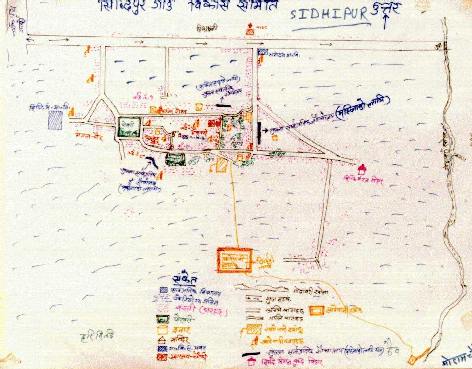

Short description of the village
A report submitted by the participants from the Siddhipur VDC.
| Sidhipur is an old compact agricultural village
has a very high population density with about 7000 inhabitants in 1200 houses on 5 ha.
Most of the houses are old and not very well maintained. The old, very well designed
infra-structure was very neglected. The streets were dirty, drainage channels were not
maintained, most of them were blocked. The quantity of drinking water is no problem, it has a good drinking water system in old wells. Besides that there is a drinking water line from the hill. The (bacterial) quality is due to upstream river pollution discutable. Because of ground water pollution the water in the wells is chlorinatated by means of a bucket with chemicals hanging in the wells. There are hardly toilets in the community, women use open defecation close to the village, most men walk to the river for defecation. Some community members purchased a double vault, poor flush latrine, through a development project some eleven years ago. Other people have very simple open toilets with collection of urine on ash from agricultural off-fall. The total enviromental situation is poor:
This leads to an environmental poor situation, with risks of water borne diseases. |
A workshop about wastewater management was organised by ENPHO, NEWAH and IRC on Nov. 5, 1998. This report is based upon the field visit made by the whole workshop team Nov. 5, 1998 and is about the problems and issues of Siddhipur community.
Siddhipur VDC which has a dominant Newar population is one of the 41 VDCs of Lalitpur District. This VDC is connected by a pitched road and lies at about 4 km East of Lalitpur Municipality. This VDC is surrounded by other 4 VDCs i.e. Lubhu in the East, Imadol in the West, Tikathali in the North and Harisiddhi (Thaiba and Godamchaur) in the South.
This VDC lies at an altitude of 1500 m from mean sea level. It occupies an area of 4.13 square kilometer of which 80% land is arable and rest 20 % has been used as public land and residential area.
There are about 1200 households in Siddhipur and it has got a population of about 7000. Ethnically, of the total population, 99.99% is Newar. Of them 85 % is Maharjan, and rests are Nemkul, Shrestha, Shakya, Amatya, Napit, Darshanadhari and Sahi. Their mother tongue is Newari. Since Siddhipur VDC is has dense Newar community following are the main problems:
It is essential to overcome above mentioned problems. But due to lack of resources it has not been possible to solve the problems. If the problem of wastewater management and use of open toilet can be solved, the adverse impact on the human health by the polluted environment could be minimised.
Following are the things found during visit in Siddhipur.
- Water is abstracted from the Godavari River, the boundary between Thaiba and Godamchaur VDCs, and collected in an intake tank from where it is transported to a reservoir tank having a capacity of 50,000 liters. The water from the tank has been distributed in the Siddhipur community via 50 public taps.
- About 8-10 dugwells and one spring has also been used for obtaining drinking water.
- By taking maintenance responsibility;
- By taking management and operation responsibility.
In view of aforesaid facts it would be appropriate to develop a programme with the involvement of local people in order to construct latrines and a sewer system throughout the community. The community itself is ready to bear 25% of the total cost of latrine construction.
|
|
The main street |
An impression of one of the centre of Sidhipur |
|
|
Grey water, polluting the street |
|
|
|
| One of the inhabitants washing the laundry at one of the taps | Inspecting a well |
|
|
A discussion about the quality of the tap water |
A good chance that the waste water from the tap influences the quality of the water in the well |
|
|
Roshan Shresta, one of the participants, interviewing people from Sidhipur |